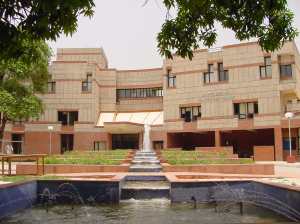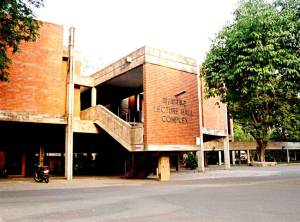IIT – Background

The Indian Institute of Technology Kanpur (IIT Kanpur) is the fourth sibling of IIT family was established in 1960 under the technical assistance of Kanpur-Indo American Programme – KIAP. The initiative was well supported with 9 leading American institutes. Under the Indo American programme, the faculty members from American institutes helped in setting up of academic programmes and development of laboratories for instruction as well as research.
 The institute began its operation in 1959 from HBTI Kanpur campus with 100 students. Now the institute is situated in Kalyanpur few kilometers far from Kanpur Central and has its own sprawling residential campus in 420 hectares. The institutes’ residents comprises of 2000 undergraduate students, 1500 post graduate students, 450 faculty members and 2000 supporting staff. With the path breaking innovations in both its curriculum and research the IIT Kanpur is gaining a legendary reputation.
The institute began its operation in 1959 from HBTI Kanpur campus with 100 students. Now the institute is situated in Kalyanpur few kilometers far from Kanpur Central and has its own sprawling residential campus in 420 hectares. The institutes’ residents comprises of 2000 undergraduate students, 1500 post graduate students, 450 faculty members and 2000 supporting staff. With the path breaking innovations in both its curriculum and research the IIT Kanpur is gaining a legendary reputation.
 Halls of residence, faculty and staff houses and community buildings surround the central academic area to provide flexibility in movement and communication. The residential campus is planned and landscaped with a hope for environmental freedom. The Architectural design of IIT Kanpur is prepared by Mr.Achyut Kanvinde. The IIT Kanpur campus reflects cultural diversity of India.
Halls of residence, faculty and staff houses and community buildings surround the central academic area to provide flexibility in movement and communication. The residential campus is planned and landscaped with a hope for environmental freedom. The Architectural design of IIT Kanpur is prepared by Mr.Achyut Kanvinde. The IIT Kanpur campus reflects cultural diversity of India.
 Since its inception, the IIT Kanpur is striving for excellence in research and education. In meeting this challenge, the Institute has always been making special efforts to recruit talented faculty and admit brilliant students from all over the country by a careful selection process. The institute offers best facilities to its students and faculty members.
Since its inception, the IIT Kanpur is striving for excellence in research and education. In meeting this challenge, the Institute has always been making special efforts to recruit talented faculty and admit brilliant students from all over the country by a careful selection process. The institute offers best facilities to its students and faculty members.
History
IIT Kanpur was established by an Act of Parliament in 1959. The institute was started in December 1959 in a room in the Canteen Building of the Harcourt Butler Technological Institute at Agricultural Gardens in Kanpur. In 1963, the Institute moved to its present location, on the historic Grand Trunk Road near the village of Kalyanpur in Kanpur district. During the first ten years of its existence, IIT Kanpur benefited from the Kanpur Indo-American Programme, where a consortium of 9 US universities namely M.I.T, University of California, Berkeley, California Institute of Technology, Princeton University, Carnegie Institute of Technology, University of Michigan, Ohio State University, Case Institute Of Technology and Purdue University helped set up the research laboratories and academic programmes.[1] The first Director of the Institute was Dr. P. K. Kelkar (after whom the Central Library was renamed in 2002).
 Under the guidance of economist John Kenneth Galbraith, IIT Kanpur was the first institute in India to offer Computer Science education. The earliest computer courses were started at IIT Kanpur in August 1963 on an IBM 1620 system, a novelty then even in many North American and European universities. In 1971, the institute initiated an independent academic program, leading to M.Tech. and Ph.D. degrees.
Under the guidance of economist John Kenneth Galbraith, IIT Kanpur was the first institute in India to offer Computer Science education. The earliest computer courses were started at IIT Kanpur in August 1963 on an IBM 1620 system, a novelty then even in many North American and European universities. In 1971, the institute initiated an independent academic program, leading to M.Tech. and Ph.D. degrees.
Notable Alumni
List of some notable Indian Institutes of Technology alumni

-
Dr Chandra Kintala, Director, Yahoo! Labs, Bengaluru, India; Director(Retd.), Bell Labs, USA
-
Ashoke Sen (String theorist), HCRI, Allahabad
-
N.R. Narayana Murthy (founded the software corporation Infosys), M.Tech (EE) 1969-1971.
-
Manindra Agrawal, Nitin Saxena, and Neeraj Kayal (proved with their AKS primality test that primality testing has a polynomial time algorithm, a major result in theoretical computer science)
-
Avanidhar Subrahmanyam: Notable professor at UCLA, expert in the field of behavioral finance, great-grandson of Patanjali Sastri, Goldyne and Irwin Hearsh Chair of Money and Banking
-
Pradeep Sindhu (Founder – Juniper Networks)
-
Ashok Jhunjhunwala (Padma Shri and Professor, Dept of Electrical Engineering, IIT Madras)
-
Satyendra Dubey (Whistle-blower whose murder shocked the nation)
-
Ayyalusamy Ramamoorthy, scientist in the area of NMR and biological membranes.
-
Duvvuri Subbarao, 22nd Governor of Reserve Bank of India
-
Dr. Shiraz Minwalla, (String Theorist)
-
Dr. Mriganka Sur, (Neuro Scientist), Sherman Fairchild Professor of Neuroscience, Head, Dept of Brain and Cognitive Science MIT, Fellow of Royal Society










